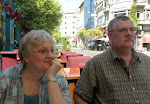I went to the Ranch twice more, both times as a chaperone for a free day for the middle schoolers who chose that activity. During the last week of classes at MEF, there are no classes. Students choose activities and field trips. So on Tuesday, I was among the teachers overseeing a football tournament in the morning, and a swimming tournament in the afternoon. The football tournament consisted of mixed-gender teams that played in a gym on a basketball court. Each team had five players. There were no off-sides, and balls could be played off of the walls. It is much more exhausting than regular soccer, because there is seldom a time when the ball is not close to one of the four forwards. Tired players would switch off at goalie. Games lasted 15 minutes. The level of play was intense; the sixth-grade boys made it into the semi-finals, losing to the eventual winners. The swimming tournament was just a bunch of silly games.
.
Next day I was back at the Ranch. I decided to really explore the facility, so I started walking around the perimeter next to the high stone walls. Here’s what I saw (in order of appearance):
- A concrete basketball court
- A rose garden with many different varieties
- A double tennis court
- A man-sized chess board
- Staff apartments -- the building looked like a two-storey motel
- Flowering shrubs along all paths -- all paths featured large, flat pieces of marble embedded in the ground
- Chickens, ducks, geese and peafowl wandering free
- 16 sheep and lambs in a pasture with 8 miniature deer (4 each by gender)
- 4 fruit orchards
- Several large horse stalls, no horses in sight
- A duck pond
- The concrete lake mentioned earlier, with a fake waterfall that flowed under a stone bridge
- 2 black swans swimming in the fake lake
- 2 large greenhouses. The first featured short, broad-leafed palms, various herb gardens, and potted trees. Two covered women were working in the room, one hoeing around the palms, the other planting herbs. The second green house was dedicated solely to tomatoes. Arikan sells these to his schools.
- A field of grapes
- A cherry orchard
- A crowed artichoke patch -- they grow up on long stems, reminding me of Brussel sprouts
- 2 smaller green houses dedicated to herbs
- A mint patch with brilliant blue flowering tops
- A helipad -- I surmised that this must have been the spot from which I had seen Saturn during my first visit
- A large arboretum dedicated mainly to evergreen trees
- The Arikan Palace, a huge dwelling with a central tower emblazoned with a bold IA for Ibrahim Arikan. Another huge rose garden
- Another guard house, the guards sipping tea and watching me closely in case I decide to storm the Palace
- A man with a weed-eater, buzzing out grass and weeds from between the bricks in the parking lot in front of the Palace. It is clear these people live here year-round maintaining the grounds for a family that lives there only during the summer months.
.
